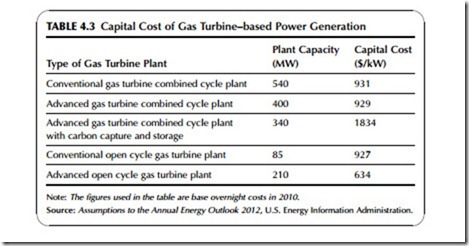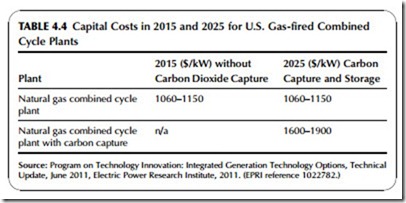COST OF GAS TURBINE–BASED POWER GENERATION
The capital cost of a gas turbine–based power plant depends primarily on the cost of the gas turbine. This is a high-technology component that is manufactured by a small number of companies, mostly based in developed countries. However, even the largest gas turbines are off-the-shelf components that can be supplied virtually ready to operate. Competition between different manufacturers is stiff, and in many cases the key negotiating tool is price. As a consequence, gas turbines tend to be extremely competitively priced and they represent one of the least capital cost forms of power generation, particularly in the shape of a large combined cycle power plant.
Against that, the fact that gas turbines are high-technology components means that their cost will always be affected by shifts in commodity prices for the materials, especially the metals, from which they are built. This will be magnified in a combined cycle plant as a result of the cost of the heat- recovery steam generator, made primarily from steel and the steam turbine, again built mostly from steel. However, the fact that major components of a combined cycle plant can be delivered ready-assembled reduces labor costs.
Table 4.3 contains costs for gas turbine–based power plants in the U.S. market, based on analysis by the U.S. Energy Information Administration (EIA). While costs in other parts of the world will differ, the fact that these units are traded, internationally, means that prices are likely to be similar, whatever market is being considered. Based on this U.S. EIA analysis, which considers costs for plants in year 2010 U.S. dollars and where the order was placed in 2011, the cost of a conventional natural gas–fired combined cycle plant is
$931/kW. An advanced combined cycle plant with the most efficient gas tur- bines available would actually be slightly cheaper at $921/kW. Typical plant sizes for these two types of plant are shown in Table 4.3.
Carbon capture and storage is expected to increase the cost of fossil fuel power generation considerably. In Table 4.3, the cost for an advanced gas turbine combined cycle plant with carbon capture and storage is estimated to be $1834/kW, or slightly under twice the cost of either type of plant without carbon capture and storage. A conventional open cycle gas turbine plant, likely to be used primarily for peak power and grid support services, costs $927/kW or virtually the same as the combined cycle plants without carbon capture and storage. This plant would, however, operate with significantly lower efficiency than the combined cycle plant, as explained before. Meanwhile, an advanced gas tur- bine in an open cycle configuration is expected to cost $634/kW. The two types of open cycle plant are expected to have a lead time from order to entering service of two years. For the combined cycle plants the lead time would be three years.
Table 4.4 shows some future costs for combined cycle power plants burning natural gas based on a report from the U.S. Electric Power Research Institute (EPRI). Again, the figures apply to the U.S. market but should be broadly indi- cative of prices elsewhere. EPRI calculated that a combined cycle power plant without carbon capture entering service in 2015 would have a capital cost of $1060–1150/kW. EPRI expects the cost to be broadly unchanged in 2025. Meanwhile a similar plant, but with carbon capture, is predicted to cost between $1600/kW and $1900/kW.
The low capital cost of gas turbine–based power generation is one of the reasons why they have been favored by private sector companies operating in the liberalized electricity markets established around the world. The cost
remains low compared to most other technologies even when carbon capture and storage is included. However, that does not necessarily translate into a low cost for electricity generated by these plants.
The main problem with natural gas–based power generation is the cost of gas. When this is low, combined cycle power plants are extremely competitive sources of electric power. However, when prices rise, and in global energy markets the price can rise extremely rapidly, they can become far from economical. The uncertainty attached to the volatility in gas prices can also have a damaging effect on the economic growth in countries that rely heavily on gas-fired generation.
The IEA predictions of a golden age of gas, if they come to pass, may lead to a loosening of gas supplies, a lowering of average prices, and a reduction in volatility. If so, then gas-fired generation is likely to thrive well into the 21st century.

